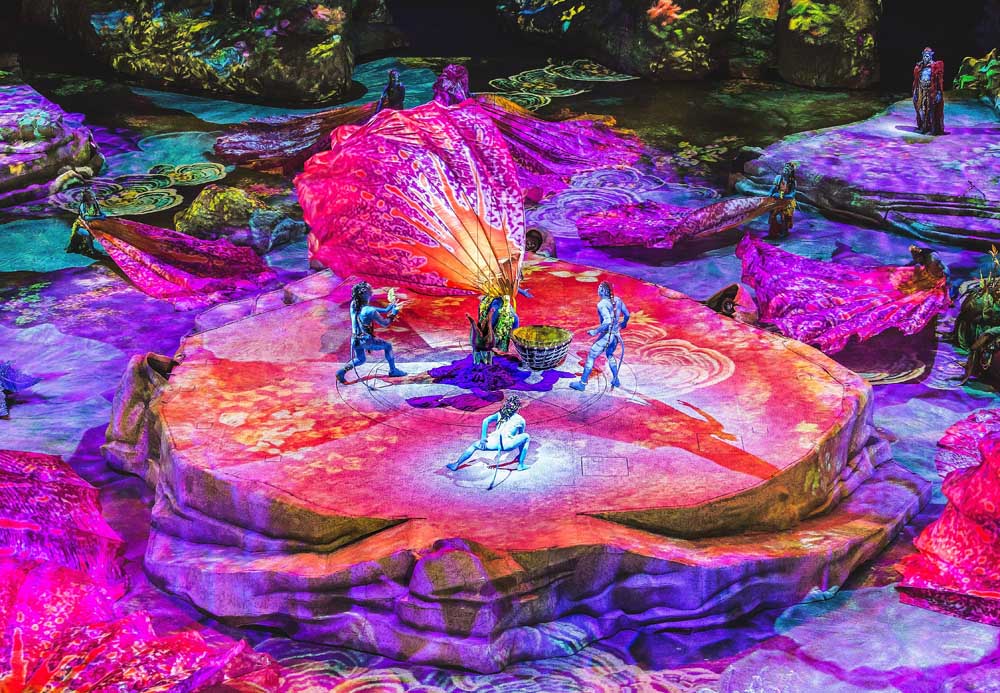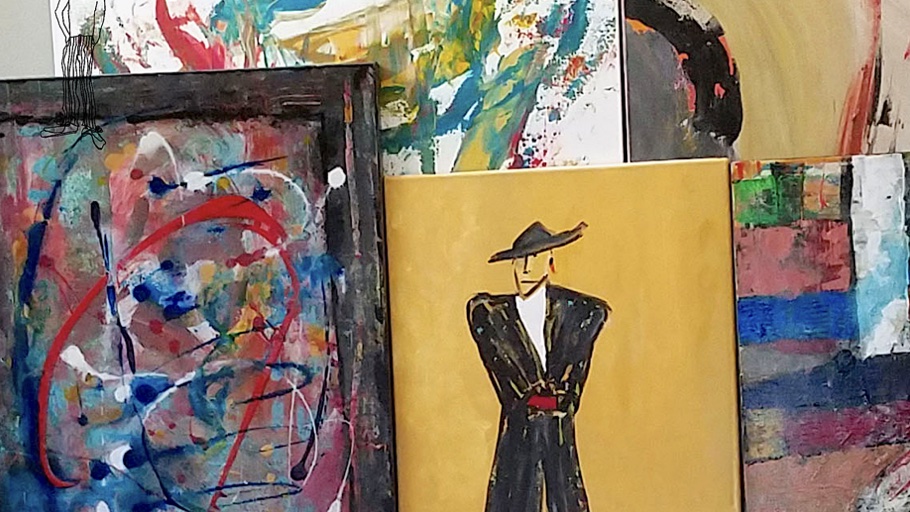Cirque du Soleil has 7 separate shows in Las Vegas
Published 4:22 pm Friday, February 24, 2017

- Long-tailed Na'ví approach a fantastical flower in a touring production of "Toruk," based upon the movie "Avatar." The curious creatures, who move with feline grace in long toe-to-heel strides, are a challenge to dancers in the Cirque du Soleil show. (Kym Barrett / Courtesy of Cirque du Soleil)
LAS VEGAS —
Something doesn’t seem quite right.
Trending
I am sitting comfortably in my seat at the Mystère Theatre, in the Treasure Island Hotel & Casino on the Las Vegas Strip, waiting for the Cirque du Soleil show to begin. I let my eyes drift around the 1,540-seat theater and its revolving stage, catching glimpses of colorfully clad members of the “Mystère” cast scurrying furtively along the surrounding walkways.
One usher, decidedly past his prime, his face powdered and his hair looking shocked, is particularly loud as he seizes tickets from a puzzled pair of show-goers and insists on walking them to their seats. He leads the man and woman toward the front of the stage, then realizes he is going in the wrong direction. So he tears up the tickets, and with the couple in tow forces his way through an entire row of ticket holders until he locates seats in another part of the theater.
But he’s not done yet. He absconds with the woman’s popcorn, which he begins spilling and throwing at various audience members.
As it turns out, the clown “Brian Le Petit” is part of the act. His awkwardness sets the stage for the rest of the 90-minute show, which begins with the appearance of a ringmaster whom he mercilessly heckles (and who, in real life, is his son).
“Mystère” is everything a 21st-century circus should be. It combines aerials, acrobatics and choreographed dance with elaborate sets and costuming. Gymnastic trampoline and teeterboard performances, hand balancing and aerial silks, share time with the fabled “men on the flying trapeze.”
Musicians provide a thread, from a troupe of taiko drummers to a pair of “chanteuse plumes” (feathered singers) whose haunting melodies float across the theater from a balcony high above the stage. Enormous babies and long-legged giants, birds and chameleons and an omnipresent snail, are only a few of the whimsical characters who appear on stage.
Trending
Through it all, Brian Le Petit keeps patrons laughing. Most of them, anyway. At one point of the show, he convinces a man to come on stage, where he is locked into a box for purposes of art. Then Le Petit returns to the audience, where he cozies up with the man’s date as the show continues.
The Cirque phenomenon
Cirque du Soleil — literally “Circus of the Sun” — got its start in Montréal in 1984. Two former street performers, Guy Laliberté and Gilles Ste-Croix, won a Canadian government grant to help them launch a contemporary circus.
Thirty-three years later, Cirque is the largest theatrical producer in the world. But the company remains based in Montréal’s inner-city neighborhood of Saint-Michel, in the heart of the French-speaking province of Québec. It’s no accident that a European flair persists in every one of its productions.
Of 20 circuses currently being presented worldwide, seven of them, or more than one-third, are resident in Las Vegas.
New York, Orlando and Mexico’s Riviera Maya each have a resident show. Ten others are on tour internationally in Canada, England, Australia, Argentina, Mexico and Japan, as well as various parts of the United States. “Ovo,” a depiction of the inner world of insects, is presently (and briefly) in Spokane, Washington, while “Luzia: A Waking Dream of Mexico” will move from San Jose, California, to suburban Seattle for an eight-week show on March 31.
The original 1984 Cirque employed 20 street performers. Today the company has 1,300 performing artists from nearly 50 countries, and about 4,000 employees in various capacities. Various productions have been seen by more than 160 million spectators in 400 cities worldwide, as it has covered 60 countries on six continents. Seventeen shows have been retired, either permanently or temporarily; but the technical quality of the artistic productions keeps getting better and better.
It’s in Las Vegas that Cirque has achieved its greatest fame. In addition to “Mystère,” its original Treasure Island show since 1993, it offers “Kà” at the MGM Grand, “O” at the Bellagio and “Zumanity” at New York-New York. Musical themes dominate “The Beatles LOVE” at the Mirage and “Michael Jackson ONE” at the Mandalay Bay, while magician Criss Angel befuddles the audience in “Mindfreak! Live” at the Luxor.
“O” is an aquatic adventure performed both above and in a giant tank. “Zumanity” has a sexy burlesque theme. “Kà” weaves martial arts and Asian inspiration into a single theme.
“Mystère” was the trailblazer of the Vegas experience. Originally planned with a theme of Greek and Roman mythology for Caesars Palace, it was rejected by casino executives who considered it too great a financial risk at a time when feather boas dominated ballroom revues. “The people who opened the door for something new were Siegfried and Roy,” set designer Michel Crête told “A Vegas Guide.” “They were the first to move away from the ‘Folies Bergère’ thing” in their magic show with white tigers, beginning in 1990 at the Mirage.
It was 1993 before Treasure Island, under the same ownership as the Mirage, took a chance on “Mystère,” giving it a permanent home with its own theater — rather than a circus tent like Cirque’s touring productions.
Today, Vegas visitors can get morning or afternoon previews of “Mystère,” “Kà” or “The Beatles LOVE” at no charge. Thirty-minute open rehearsals include demonstrations of gymnastic skills by a few of the cast artists. Those in attendance are given a voucher to redeem at the box office for substantially discounted seats. Visitors should check at hotel box offices for specific schedules.
The Kà experience
Having enjoyed “Mystère” so thoroughly, and having on a previous occasion enjoyed “The Beatles LOVE,” I purchased a ticket for “Kà,” a show with a strong Asian and martial-arts theme. Each Cirque du Soleil production, I discovered, has distinct similarities — the athleticism of its cast members is spectacularly displayed — yet each stands on its own in production values.
“Kà” premiered in 2005 as the first show developed specifically for Las Vegas, and the first with a cohesive storyline. Named for the ancient Egyptian concept of a spiritual double that travels with every human through this life and into the next, “Kà” follows imperial twins, a brother and sister, who are separated by battle as they come of age. Unexpected rites of passage lead them to self-discovery not only of themselves, but of their love for others.
The initial production cost $165 million to mount, with $100 million of that devoted to the theater, at once ancient and futuristic. Think “Mad Max” meets “Blade Runner.” Every one of the theater’s 1,950 seats is equipped with a pair of ear-level speakers, and hundreds more are purposefully placed around the auditorium. This enables a dynamic surround-sound audio experience with sound effects and music that can be targeted to specific sections of the room.
Pyrotechnics, puppetry and multimedia projects help to relate the story. Asian culture-inspired costumes worn by the 80 cast members; the lavish silks worn by martial artists and members of the imperial court draw comparisons to China, Japan and India. Fight scenes incorporate full-contact Wushu martial arts, Brazilian capoeira and poi staves for manipulating fire. Chinese opera and Japanese kabuki are evident in the choreography.
For all the production’s marvelous effects, however — including a humble mountain tribe’s tent that is transformed into a flying device enabling them to escape hostile raiders — the true star of the show is the stage, made up of seven separate moving platforms that include the giant Sand Cliff Deck.
Six feet thick, 25 feet by 50 feet in dimension and weighing 50 tons, this deck and other platforms enable action to be carried through multiple dimensions. Nets and air bags catch acrobats falling from as high as nine floors above the stage to four floors below, a tumble of about 15 stories to an area hidden from audience view. Hydraulics and a vertical crane control the deck’s movement, lifting it vertically, rotating it 360 degrees and tilting it from flat to a precipitous wall. Climbing pegs sprout from the floor’s surface during one scene. In another, a sandy beach is simulated by granulated cork, imported from Portugal.
Virtual reality
I was glad to have seen “Kà” before witnessing my favorite scene again through a VR headset. But having close personal encounters — virtual stare-downs — with malevolent archers as they pursued the imperial twins put a whole new spin on the drama.
My most recent visit to Las Vegas occurred during the 2017 Consumer Electronics Show, held annually in January. A hot topic at this year’s event, attended by more than 150,000 people from all over the world, was virtual reality devices that enable one to not only witness an activity, but to behold that adventure from the inside. Climbing Mount Everest and swimming with whales were two of the more popular demonstration reels.
As usual, Cirque du Soleil was at the vanguard of this new technology. In the central lobbies of both the MGM Grand, home of “Kà,” and the Bellagio, home of “O,” technicians fitted Samsung VR headsets to curious guests seated in chairs with 360-degree motion for a three-dimensional viewing experience.
Created by Felix & Paul studios, the glimpses were brief (13 minutes) but memorable. “Kà: The Battle Within” was filmed on the Sand Cliff Deck as the girl twin, attended by her gallant valets and devoted nursemaid, climbs a perilous peak pursued by the evil archers. With choreography at once horizontal and vertical, the camera is challenged with keeping viewers in motion as the action surrounds them. I didn’t fall, so I must have been holding firmly to a climbing peg as I twisted in space in apparent defiance of gravity.
“Dreams of O” left me with much the same sensation, except that I was submerged. I floated in a watery dream as various strange, amphibious beings — striped zebras, clowns, a masked thief, a wise old man — approached to study my visage. In turn, I watched in awe as they performed synchronized acrobatics and created circles of fire in our oceanic lair. Combining slow-motion and underwater photography, this video convinced me that I will see “O” on my next Vegas visit.
By then, perhaps, additional Cirque du Soleil-themed VR experiences will have been filmed and released.
Dance rehearsal
The newest Cirque du Soleil arena production, and its 37th overall, is “Toruk – The First Flight.” The touring company is presently in Mexico, but in January, during a stop in Las Vegas, two of its cast members hosted a master class at the Las Vegas Academy, giving high school juniors and seniors a taste of what it’s like to be a professional show dancer.
Toruk (pronounced “to-ROOK”) is based upon the Oscar-winning James Cameron movie, “Avatar.” Among its main characters are the Na’ví. About 10 feet tall, these curious creatures move with feline grace in long, toe-to-heel strides.
“Let your body flow,” instructed dancer Christian Sanchez, a Las Vegas resident on a rare visit home. “This is not a gymnastic event. And get used to having a tail.” A wave of laughter rippled through the dance class, which included at least eight young men among its nearly 30 members.
In a Q-and-A session after the class, Sanchez and fellow artist Viktor Franyo encouraged students to explore a variety of dance and movement practices if they have any thought of someday working with Cirque du Soleil. Sanchez said that he himself had studied hip-hop dancing, gymnastics, circus and aerials before landing with the company.
Cirque conducts annual auditions in Vegas and online, he said, but successful applicants still may wait years for a callback. “The company will keep you in a pool and place artists where their skills fit best,” he explained.
But Brian Dewhurst, the 84-year-old actor who plays clown Brian Le Petit in “Mystère,” didn’t wait for a call-back. There are some people whose clownish attitudes just fit, right from the start.
— John Gottberg Anderson can be reached at janderson@bendbulletin.com.
In two weeks: Shakespeare Festival in Ashland
If you go
INFORMATION
Cirque du Soleil: 8400 Deuxieme Ave., Montréal, Québec, Canada H1Z4MT. cirquedusoleil.com,
Las Vegas Convention & Visitors Authority: 3150 Paradise Road, Las Vegas; lvcva.com, 702-892-0711, 877-847-4858.
CIRQUE DU SOLEIL
The Beatles LOVE: The Mirage Hotel & Casino, 3400 Las Vegas Blvd. S.; mirage.com/ en/entertainment/the-beatles-love.html. Box office 702-792-7777 or 800-963-9634. Shows 7 and 9:30 p.m. Thursday to Monday. Tickets from $55.
Kà: MGM Grand Hotel and Casino, 3799 Las Vegas Blvd. S.; mgmgrand.com/en/ entertainment/ka-cirque-du-soleil-show.html. Box office 702-531-3826 or 866-740-7711. Shows 7 and 9:30 p.m. Saturday to Wednesday. Tickets from $81.
Michael Jackson ONE: Mandalay Bay Resort and Casino. 3950 Las Vegas Blvd. S.; mandalaybay.com/en/entertainment/michael-jackson-one.html. Box office 702-632-7580 or 877-632-7400. Shows 7 and 9:30 p.m. Friday to Tuesday. Tickets from $69.
Mindfreak! Live: Luxor Las Vegas. 3900 Las Vegas Blvd. S.; luxor.com/en/ entertainment/criss-angel-mindfreak-live.html. Box office 702-262-4400 or 866-353-5625. Shows 7 and 9:30 p.m. Wednesday to Sunday. Tickets from $85.
Mystère: Treasure Island Hotel & Casino. 3300 Las Vegas Blvd. S.; treasureisland.com/ shows/2/mystere-by-cirque-du-soleil. Box office 702-894-7722 or 800-392-1999. Shows 7 and 9:30 p.m. Saturday to Wednesday. Tickets from $49.50.
O: Bellagio Hotel and Casino. 3600 Las Vegas Blvd. S.; bellagio.com/en/entertainment/ o-by-cirque-du-soleil.html. Box office 888-488-7111. Shows 7 and 9:30 p.m. Wednesday to Sunday. Tickets from $98.50.
Zumanity: New York New York Hotel & Casino. 3790 Las Vegas Blvd. S.; newyorknewyork.com/en/entertainment/zumanity.html. Box office 866-606-7111. Shows 7 and 9:30 p.m. Friday to Tuesday. Tickets from $69.








